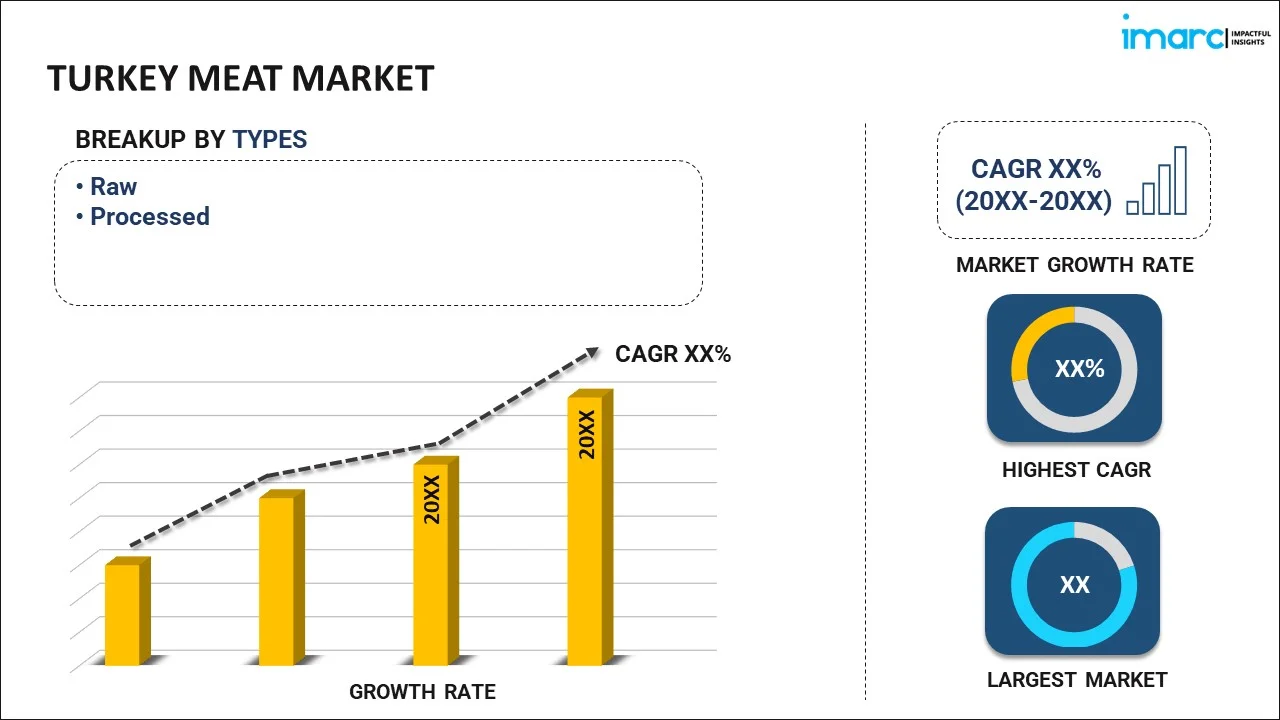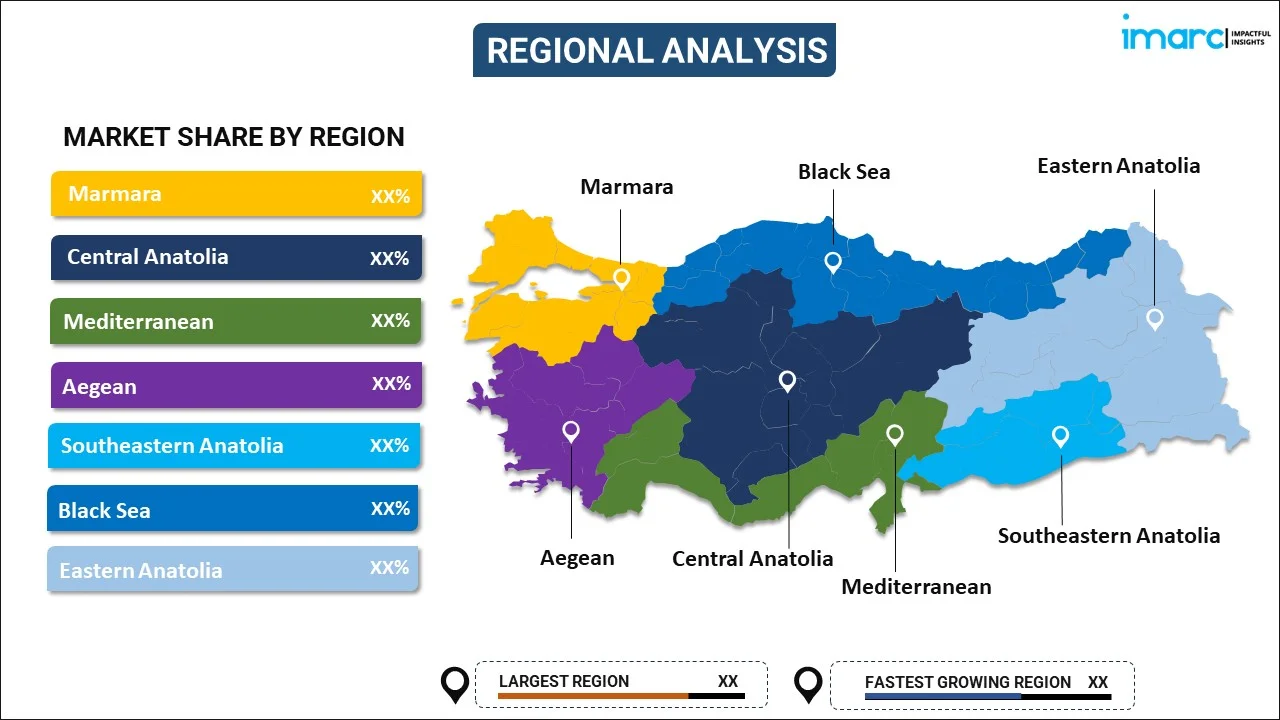
Turkey Meat Market Report by Type (Raw, Processed), Product (Chicken, Beef, Mutton, and Others), Distribution Channel (Supermarkets and Hypermarkets, Departmental Stores, Specialty Stores, Online Stores, and Others), and Region 2025-2033
Turkey Meat Market Overview:
The Turkey meat market size is projected to exhibit a growth rate (CAGR) of 4.9% during 2025-2033. The rising global population, increasing disposable incomes, urbanization, dietary shifts towards protein-rich foods, advancements in meat production technologies, and expanding food service sectors, alongside growing demand for processed and convenience meat products, are some of the factors influencing the market growth.
|
Report Attribute
|
Key Statistics
|
|---|---|
|
Base Year
|
2024 |
|
Forecast Years
|
2025-2033 |
|
Historical Years
|
2019-2024
|
| Market Growth Rate (2025-2033) | 4.9% |
Turkey Meat Market Trends:
Increasing Demand for High-Quality and Premium Meat Products
The quality of the meat that consumers eat is becoming increasingly important to them. There is a growing preference for high-quality, organic, and ethically sourced meat products. This trend is driven by a combination of factors, including health consciousness, environmental awareness, and animal welfare concerns. People are willing to pay a premium for meat that is free from antibiotics, hormones, and other additives. The demand for grass-fed beef, free-range poultry, and heritage pork is increasing as these products are perceived to be healthier and more sustainable. Furthermore, consumers are more inclined toward how meat is produced; thus, transparency about the food has become vital for consumers. Likewise, the demand for premium meat products has also increased with emerging trends toward certifications and labeling that ensure quality and ethical standards, aiding in market expansion.
Rise of Plant-Based and Alternative Meat Products
The plant-based and alternative meat sector is experiencing exponential growth as consumers seek sustainable and health-conscious alternatives to traditional meat. Concerns about environmental sustainability, animal welfare, and personal health drive this trend. On average, 28% of Europeans consume at least one plant-based food alternative weekly, up from 21% in 2021. Consequently, the rise in plant-based meat products, made from ingredients such as soy, peas, and wheat, that mimic the taste and texture of real meat is providing an impetus to the market growth. Additionally, lab-grown meat, also known as cultured meat, is emerging as a viable alternative, grown from animal cells in controlled environments, reducing the need for animal farming. Ongoing innovation in this sector, with significant investments in research and development (R&D) by startups and established food companies, is impelling the market growth.
Advancements in Poultry Farming and Processing Technologies
According to government data, egg production in Turkey has risen steadily from 95 billion in 2017-18 to 114 billion in 2019-20, while poultry meat production grew from 3.7 MMT to 4.3 MMT in the same period. Advancements in poultry farming and processing technologies drive these increases. Innovations in breeding, feed efficiency, and disease control have enhanced production yields and meat quality. Modern techniques like controlled-environment agriculture and precision farming create optimal growth conditions, leading to healthier birds. On the processing side, advancements in automation and food safety have streamlined production, reduced costs, and ensured high hygiene standards. These technological improvements boost efficiency and productivity, meeting rising market demand and maintaining competitive pricing, thereby aiding in market expansion.
Turkey Meat Market News:
- In May 2024, Kretschmar Premium Meats & Cheeses, a Smithfield Foods subsidiary, introduced two new deli meat varieties, Spiced Pineapple Ham and Lemon & Cracked Pepper Turkey Breast, as well as launched a marketing campaign in response to the growing "spicy" flavor trend. Both products are free of gluten and MSG.
Turkey Meat Market Segmentation:
IMARC Group provides an analysis of the key trends in each segment of the market, along with forecasts at the country level for 2025-2033. Our report has categorized the market based on type, product, and distribution channel.
Type Insights:

- Raw
- Processed
The report has provided a detailed breakup and analysis of the market based on the type. This includes raw and processed.
Product Insights:
- Chicken
- Beef
- Mutton
- Others
A detailed breakup and analysis of the market based on the product have also been provided in the report. This includes chicken, beef, mutton, and others.
Distribution Channel Insights:
- Supermarkets and Hypermarkets
- Departmental Stores
- Specialty Stores
- Online Stores
- Others
The report has provided a detailed breakup and analysis of the market based on the distribution channel. This includes supermarkets and hypermarkets, departmental stores, specialty stores, online stores, and others.
Regional Insights:

- Marmara
- Central Anatolia
- Mediterranean
- Aegean
- Southeastern Anatolia
- Blacksea
- Eastern Anatolia
The report has also provided a comprehensive analysis of all the major regional markets, which include Marmara, Central Anatolia, Mediterranean, Aegean, Southeastern Anatolia, Blacksea, and Eastern Anatolia.
Competitive Landscape:
The market research report has also provided a comprehensive analysis of the competitive landscape in the market. Competitive analysis such as market structure, key player positioning, top winning strategies, competitive dashboard, and company evaluation quadrant has been covered in the report. Also, detailed profiles of all major companies have been provided.
Turkey Meat Market Report Coverage:
| Report Features | Details |
|---|---|
| Base Year of the Analysis | 2024 |
| Historical Period | 2019-2024 |
| Forecast Period | 2025-2033 |
| Units | Billion USD |
| Scope of the Report | Exploration of Historical and Forecast Trends, Industry Catalysts and Challenges, Segment-Wise Historical and Predictive Market Assessment:
|
| Types Covered | Raw, Processed |
| Products Covered | Chicken, Beef, Mutton, Others |
| Distribution Channels Covered | Supermarkets and Hypermarkets, Departmental Stores, Specialty Stores, Online Stores, Others |
| Regions Covered | Marmara, Central Anatolia, Mediterranean, Aegean, Southeastern Anatolia, Blacksea, Eastern Anatolia |
| Customization Scope | 10% Free Customization |
| Post-Sale Analyst Support | 10-12 Weeks |
| Delivery Format | PDF and Excel through Email (We can also provide the editable version of the report in PPT/Word format on special request) |
Key Questions Answered in This Report:
- How has the Turkey meat market performed so far and how will it perform in the coming years?
- What has been the impact of COVID-19 on the Turkey meat market?
- What is the breakup of the Turkey meat market on the basis of type?
- What is the breakup of the Turkey meat market on the basis of product?
- What is the breakup of the Turkey meat market on the basis of distribution channel?
- What are the various stages in the value chain of the Turkey meat market?
- What are the key driving factors and challenges in the Turkey meat?
- What is the structure of the Turkey meat market and who are the key players?
- What is the degree of competition in the Turkey meat market?
Key Benefits for Stakeholders:
- IMARC’s industry report offers a comprehensive quantitative analysis of various market segments, historical and current market trends, market forecasts, and dynamics of the Turkey meat market from 2019-2033.
- The research report provides the latest information on the market drivers, challenges, and opportunities in the Turkey meat market.
- Porter's five forces analysis assist stakeholders in assessing the impact of new entrants, competitive rivalry, supplier power, buyer power, and the threat of substitution. It helps stakeholders to analyze the level of competition within the Turkey meat industry and its attractiveness.
- Competitive landscape allows stakeholders to understand their competitive environment and provides an insight into the current positions of key players in the market.
Need more help?
- Speak to our experienced analysts for insights on the current market scenarios.
- Include additional segments and countries to customize the report as per your requirement.
- Gain an unparalleled competitive advantage in your domain by understanding how to utilize the report and positively impacting your operations and revenue.
- For further assistance, please connect with our analysts.
 Inquire Before Buying
Inquire Before Buying
 Speak to an Analyst
Speak to an Analyst
 Request Brochure
Request Brochure
 Request Customization
Request Customization




.webp)




.webp)












